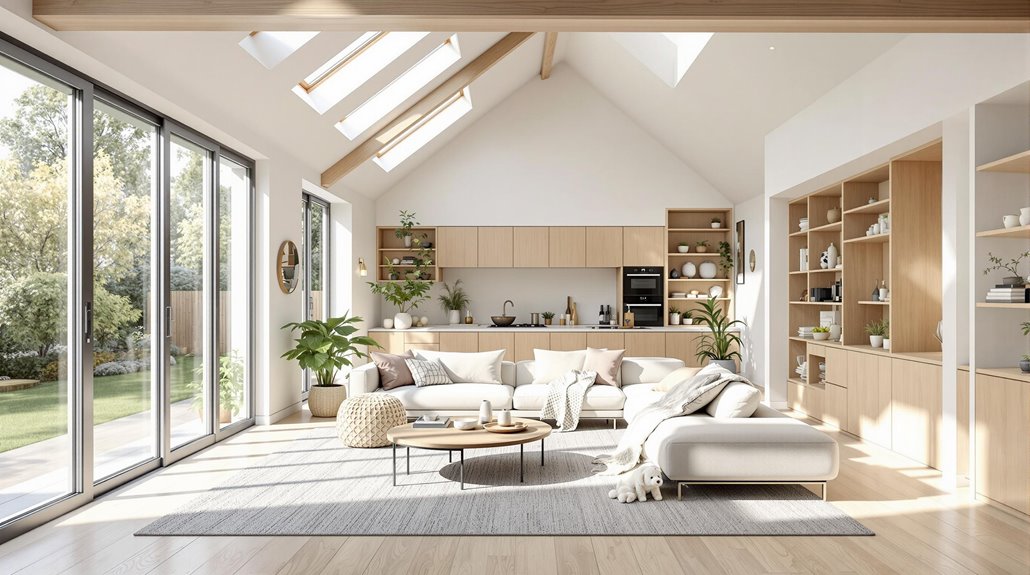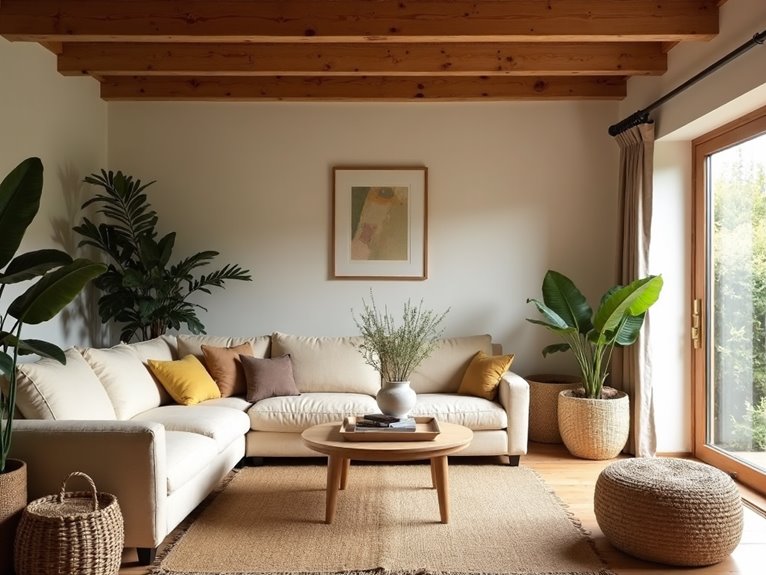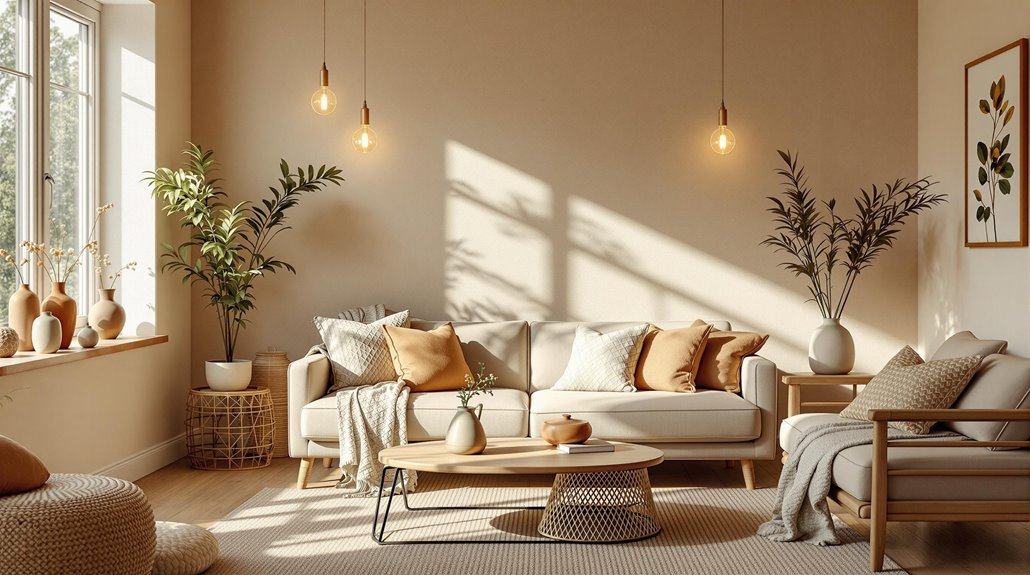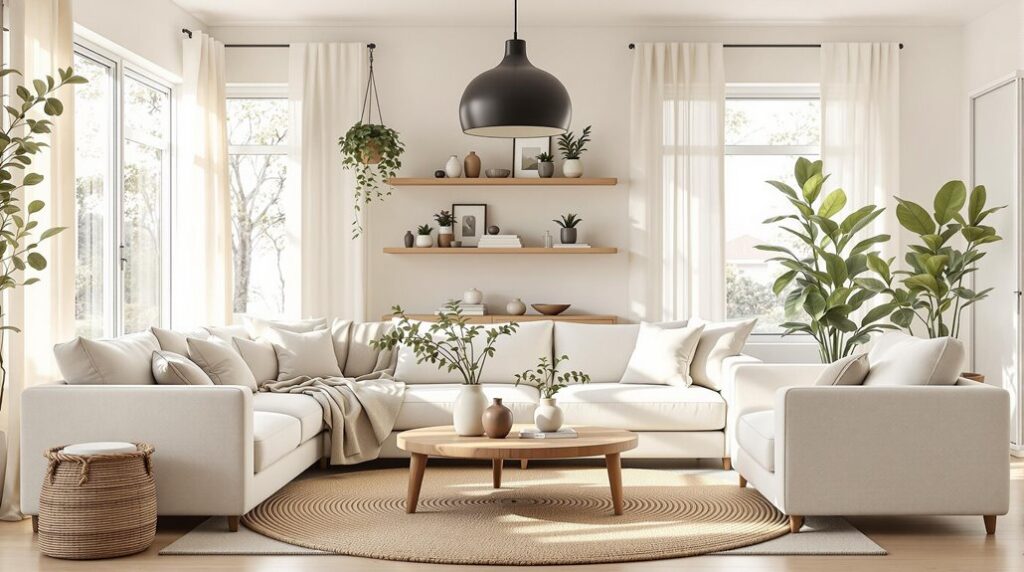I’ve spent years working with bungalow owners across the UK, and I’ve noticed they face the same fundamental challenge: making single-story homes feel spacious and inviting rather than cramped and dated. You’re probably dealing with low ceilings, compartmentalized rooms, and that persistent feeling your home lacks the character of traditional British properties. What I’ve discovered is that five specific design strategies can completely transform how your bungalow functions and feels.
Key Takeaways
- Remove non-structural walls and add floor-to-ceiling glazing to maximize natural light and create seamless flow throughout your bungalow.
- Use warm beiges, creamy whites with high LRV, and limewash finishes to establish a cozy foundation while enhancing brightness.
- Layer natural materials like stone flooring with wool rugs and terracotta tiles to add textural depth and comfort.
- Position wider sofas perpendicularly to walls and use rugs to define zones within open-plan living areas effectively.
- Install layered lighting systems with ambient, task, and accent sources plus smart controls for adaptable cozy atmospheres.
Maximizing Space and Light Through Architectural Design

How can you transform a cramped bungalow into a spacious, light-filled haven? I’ll share the architectural strategies that make the biggest impact.
Start by removing non-structural walls between your living, dining, and kitchen areas. This creates seamless flow and dramatically improves spatial perception. You’ll instantly notice how much larger your home feels. Removing walls and old fireplaces creates an open living space with double-height ceilings that enhance the sense of spaciousness. Additionally, consider incorporating modern design elements to further elevate the aesthetic of your newly opened spaces.
Consider strategic extensions if planning permits. Single-storey rear extensions work brilliantly for expanding living zones without compromising your bungalow’s character. Install floor-to-ceiling glazing in these additions to flood interiors with natural light.
Don’t overlook your loft space. Converting underused attic areas into functional rooms maximizes your footprint vertically. Add dormer windows and skylights to amplify illumination.
Finally, integrate glass throughout—replace solid partitions with glass alternatives and position skylights above high-traffic zones for consistent daylight. This approach not only enhances the flow of light but also promotes a more open and airy feeling throughout your home.
Creating Warmth With Color Palettes and Paint Techniques
While architectural changes maximize your bungalow’s physical space, the right color palette transforms how that space feels emotionally. I recommend starting with Sherwin Williams’ “Whole House” palette—warm beiges and muted taupes create that essential cozy foundation we’re after.
For your main rooms, I’d use creamy whites with LRV above 70 to reflect light while maintaining warmth. Don’t overlook taupe as your versatile base; it connects beautifully with natural materials. Incorporating modern design elements can further enhance the cozy atmosphere of your home.
Here’s where it gets interesting: try limewash finishes on feature walls for textured depth, or paint ceilings 25% lighter than walls to enhance spatial warmth. The English Cottage palette offers nine complementary paint colors that work beautifully together, taking the guesswork out of creating harmonious color schemes. North-facing rooms benefit from warm yellows with LRV 65+, while south-facing spaces work brilliantly with olive greens to prevent glare.
Incorporating Natural Materials and Textures for Comfort

Once you’ve established your color foundation, natural materials become your secret weapon for transforming sterile spaces into lived-in sanctuaries that breathe with organic life. I’ll layer stone flooring with wool rugs for tactile contrast, while exposed oak beams anchor your ceiling with structural warmth. Rattan storage units maximize your compact spaces without overwhelming them.
Your climate demands smart choices—I recommend lime-washed walls that combat UK humidity while maintaining breathability. Stone surfaces paired with underfloor heating efficiently manage cold temperatures. Layer linen curtains over wooden window frames to maximize natural light while resisting moisture warping. Incorporating renewable materials in your design can further enhance sustainability and reduce your home’s carbon footprint.
Create textural depth by combining smooth terracotta tiles in entryways with nubby wool throws on seating. These materials develop beautiful patina over time, actually improving with age rather than deteriorating. Natural materials also contribute to health improvement by reducing harmful chemicals and toxins that synthetic alternatives often introduce into your living environment.
Strategic Furniture Selection and Room Layout Planning
Natural materials set your foundation, but strategic furniture placement determines whether your bungalow feels cramped or spacious. I’ll guide you through selecting appropriately scaled pieces that maximize your compact space.
Choose wider sofas over multiple small seats—you’ll gain seating capacity without visual clutter. Position these substantial pieces perpendicular to walls, creating natural zones in open-plan areas. I recommend low-profile designs that maintain clear sightlines while anchoring your space effectively. Horizontal furniture design naturally makes your rooms appear larger than they actually are. Consider incorporating features from charming cottage extensions to enhance your living area while preserving its character.
Embrace multi-functional furniture that works harder for you. Storage ottomans serve as seats, tables, and hidden storage. Extendable dining tables adapt from intimate dinners to family gatherings. Install wall-mounted desks that fold away when you’re done working.
Use rugs under furniture groupings to define distinct zones, and let sliding doors or freestanding screens provide flexible separation when you need privacy.
Adding Personal Character Through Lighting and Decor Elements

After you’ve established your furniture layout, lighting becomes your most powerful tool for injecting personality into your bungalow’s compact spaces. I recommend creating layered lighting systems that combine ambient, task, and accent sources—this gives you complete mood flexibility through separate dimmable controls. Incorporating biophilic design principles can further enhance the connection between your indoor space and nature, making it feel more vibrant and alive.
Custom lampshades offer budget-friendly upgrades without major commitments. You can introduce texture and pattern across overhead, sconce, and table fixtures for that lived-in sophistication we’re after. Mixed-metal finishes like bronze paired with chrome add dimensional contrast while supporting eclectic aesthetics.
For authentic bungalow character, I lean toward vintage materials—smoked glass, weathered copper, and natural rattan reflect those heritage charm principles. Consider joinery-integrated lighting during any millwork planning to eliminate visible wiring while creating visual depth through focused illumination. Smart lighting systems allow you to create programmable settings that adapt your space to different activities throughout the day.
Conclusion
Transform your bungalow by removing non-structural walls to maximize flow and convert your loft for extra space. I’ll paint with warm beiges and creamy whites, then add lime-washed walls and terracotta tiles for texture. You’ll need multi-functional furniture positioned strategically, layered lighting schemes, and biophilic elements like plants or natural wood. These techniques create functional, cozy interiors that work within your bungalow’s constraints while maintaining the comfortable atmosphere you’re after.
References
- https://www.housebeautiful.com/design-inspiration/a64235120/british-design-trends-2025/
- https://www.decorilla.com/online-decorating/interior-design-trends-2025/
- https://uk.pinterest.com/scandiahus1974/bungalow-design-ideas/
- https://www.homesandgardens.com/interior-design/interior-design-trends
- https://www.thelivinghouse.co.uk/blog-interior-design-tips/top-8-interior-design-trends
- https://www.housebeautiful.com/uk/renovate/design/a64407057/small-space-stylist-tips-bungalow/
- https://www.ikonic-architecture.co.uk/upgrading-your-bungalow
- https://fifimcgee.co.uk/how-to-renovate-a-bungalow
- https://postandporch.com/blogs/news/what-is-modern-bungalow-house-design
- https://www.houzz.co.uk/discussions/4255277/help-advice-on-how-best-to-change-layout-of-bungalow

